Sproutingfam.com is supported by its readers. If you purchase through a link on my site, I may earn a commission. Learn more
Rosella Jam Recipe – Made From Fresh Hibiscus Flowers
Rosella jam is made from fresh Hibiscus flowers. These flowers are also called Rosella flowers, Roselle flowers, Agua de Jamaica (Latin countries), and there are many other names it goes by.
There are a few different species of the Hibiscus flower, but for the most part, this flower is known for its deep red color and unique tart yet palatable taste.

With a touch of honey or organic palm sugar, plus some salt, the final result on this jam is something I find myself going back to the fridge for to sneak in spoonfuls.
I love Rosella jam because of its unique taste and because of the fact that it doesn’t spike your blood glucose levels when you get a little overzealous with the spoonfuls. Here’s how it’s made..
Rosella Jam Recipe – Homemade from fresh flowers
I’ll start off with the picking of the flowers.
Here’s what the flowers look like when they’re fully budded and ready to pluck or harvest. I believe harvest is the correct terminology, but I like to say pick or pluck. You might as well not watch this or I should probably just take this down because doing it with one hand is not an enjoyable watch..
Rosella plant is a very tall plant.
It’s a hearty perennial that’s easy to grow if it’s in the proper environment. It loves the sun and grows taller the more sun it has.
We have a bunch of random Hibiscus plants sprouting up so this leads me to believe the seeds cultivate easily from bird poop.
Here’s the Roselle flowers (properly termed, “calyces”), freshly harvested from their trees.
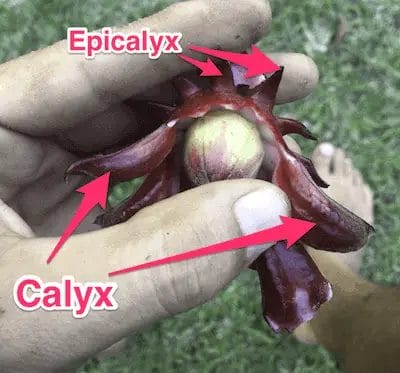
Step 1. Harvest & Peel
First you have to peel the flowers.
In the middle of the Rosella flower is an acorn looking ball that houses many smaller seeds inside..

This white ball thing is what you want to toss, save or do whatever you like with.
It’s not used for any of the recipes
Here are the seeds inside it.
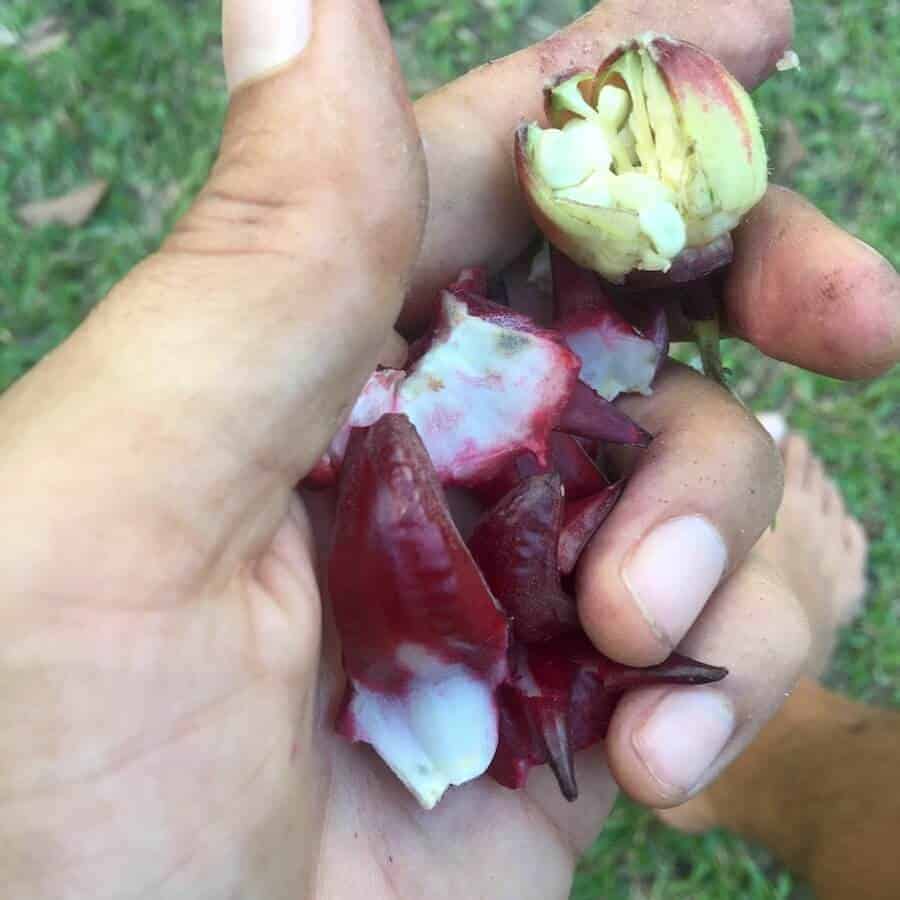
I didn’t realize how dirty my hands were when taking the pic, but they were washed before making the Rosella Jam so no worries there!
So step 1 is to peel all the petals off your Roselle flowers.

What you’ll end up with is a large bowl of Roselle flower petals.
They are thick and spiky.
I haven’t tried eating them raw, and I’m not sure if it’s suggested, but that though just came to mind as I sit here typing this out.
Step 2. Wash Really Good Before Boiling
You need to wash the Hibiscus flower petals before cooking. It’s recommended to do a triple wash to be safe.
What I do is fill up the sink with water and then drop in some iodine and baking soda.
These flowers we grew ourselves and are 100% organic, but you never know.

We live in farming country, and one of our neighbors I know uses pesticides sometimes, so there could potentially be some carry over in the air or from water run off even though our farm is very far away.
I play it safe even though my guess would be there is nothing carried over from the neighbors who are fairly far away.
Step 3. Boil Water In A Big Pot

We just used a basic pot and filled it over halfway with drinking water.
Once it starts boiling, add in the Roselle flower petals.
It will look something like this below:

At this point,
My mother-in-law says to add salt to taste once you add in the flowers.
The sweetener is not added in until it’s almost ready, but the salt is added in now at the beginning.
Step 4. Add Salt To Taste At The Beginning Of The Boil

Keep the boil going over medium heat, while constantly stirring.
If the heat is on the upper end of medium, regardless of whether you’re covering the pot or not, the roselle flowers tend to stick to the bottom.
If you have it covered, and you stop stirring, then it will rise up your pot and overflow/explode.
I didn’t get a picture of the explosion, but you can see some of it from the pics in this post or in the video.
Step 5. Stir, Stir, Stir…
Stir until the juice is almost gone.
Once its condensed into a jam like substance, it’s ready.
But before it’s fully condensed, you can add the sweetener of your choice.
It will be a substance that looks somewhat like this at the point of adding the sweetener:

Step 6. Sweeten to taste
Let it cool down, and at this point you can add more honey or sugar to taste.
My mother in law unloads a whole bag of brown sugar in it to make it taste really, really good. But it has way too much sugar.
I prefer to add some honey or sugar bit by bit because although it’s great super sweet, it’s also just as good without being over sweetened.
The salt balances out the tartness and it’s almost perfect as is with just salt.
However, to make it even more addicting, you can add some sweetness.
Honey blends with it perfectly. You can’t taste the honey, and it doesn’t affect the original Hibiscus flower flavor at all. For this reason, I think honey is the best sweetener for this Rosella Jam.
However, fresh stevia leaves would also make a great sweetener. I’d use the extracts with caution, but if you have some fresh or dried stevia leaves, you can boil them in water and use that ‘stevia tea’ to sweeten the Roselle flower jam.
This will just make it slightly less carb loaded.
Hibiscus tea is full of really great health benefits. I will have to make a whole new post about its health benefits because there are literally almost 100 that some cultures have used this “superfood” for since centuries back.
Rosella Jam Printable Recipe Card
Rosella Jam Recipe
Ingredients
- 1 tsp sea salt
- 5 tbsp organic honey
- 1 pound Hibiscus flower freshly peeled
Instructions
Video
Notes
NutritionFacts.org shares nutrition facts for Hibiscus. The nutritional information is for Hibiscus tea, but you can translate that for the jam. The jam will have more carbs since you actually eat the flowers, but the rest is the same other than the amounts of salt and type of sweetener you decide to use.
Related Read: This is the first recipe post up on the blog, but I plan on adding more as we make them at the house. To follow along you can subscribe to our newsletter where I will alert you of each new recipe published, or you can bookmark our recipe page and come back in the future.
Thanks for stopping by Sprouting Fam!
We’d love to know about your Roselle Jam experiences!
NEXT: View the Roselle Juice recipe version (Made with the same recipe, this ones shares how to make the juice, plus more information about Roselle).

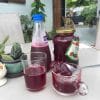
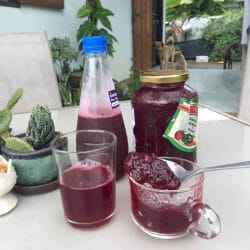
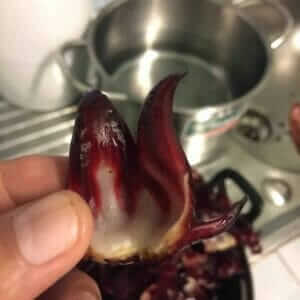
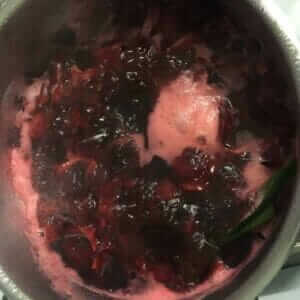
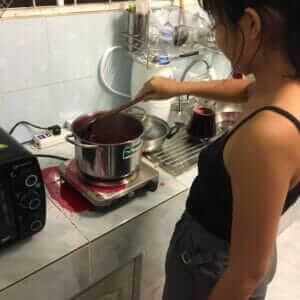
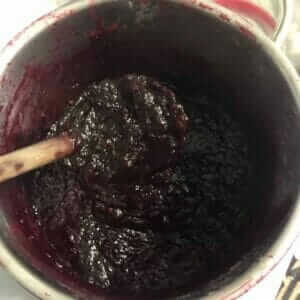
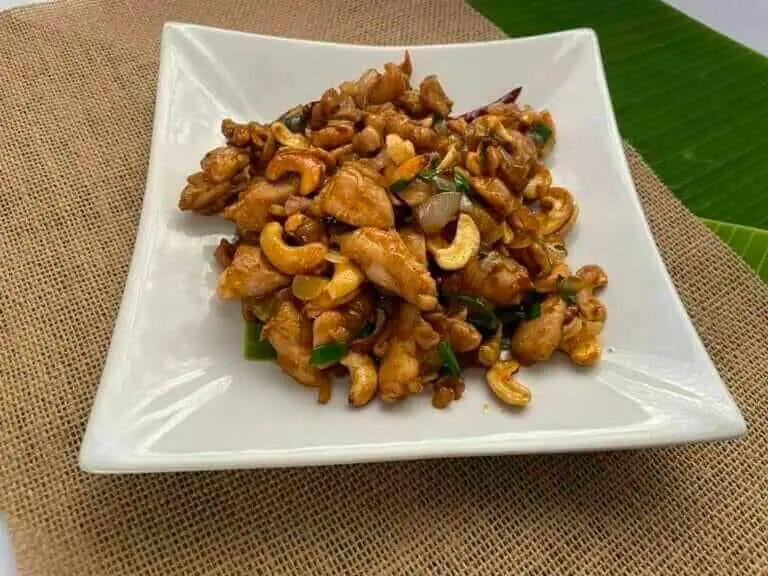
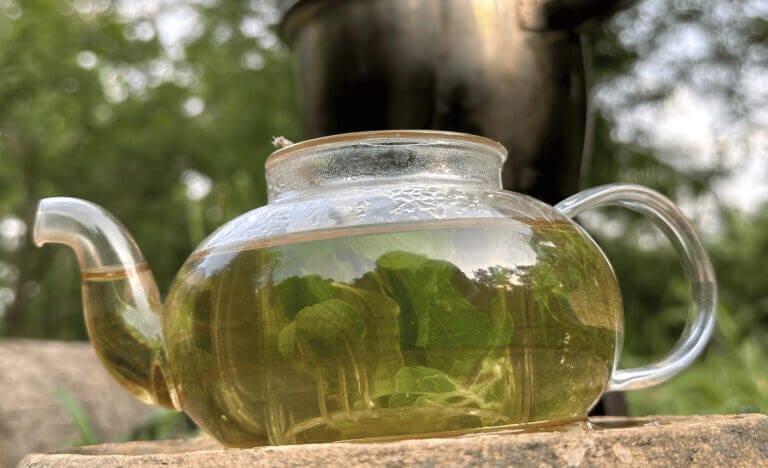
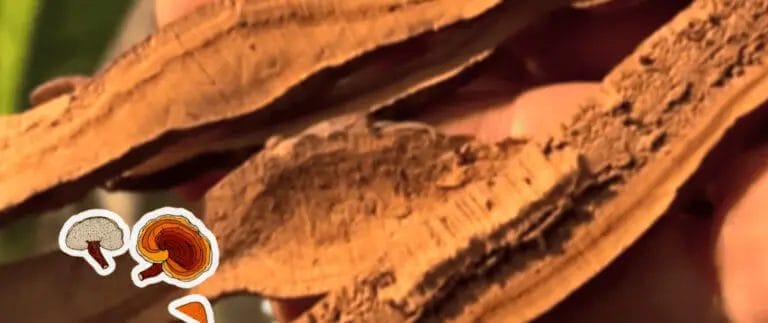
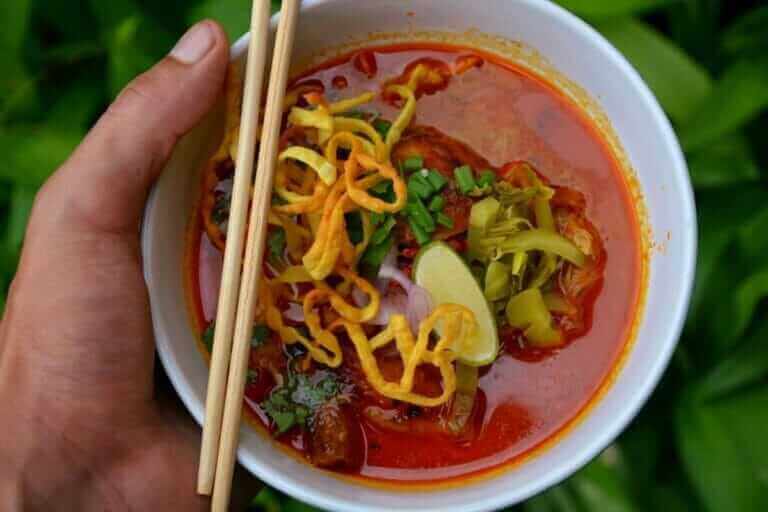
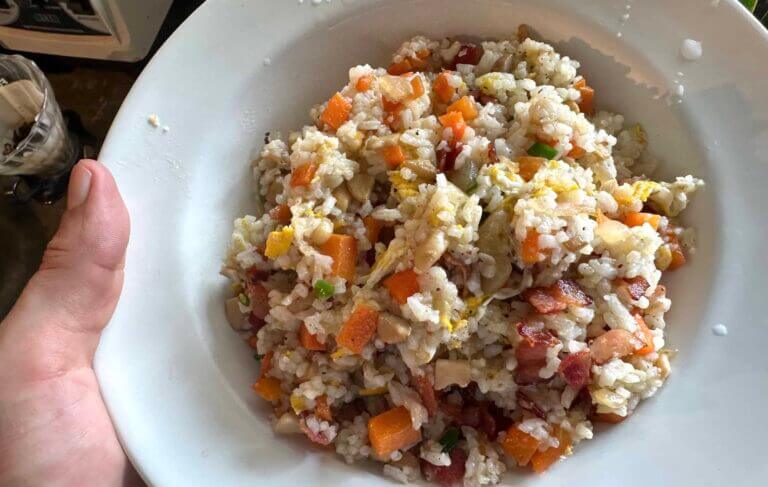
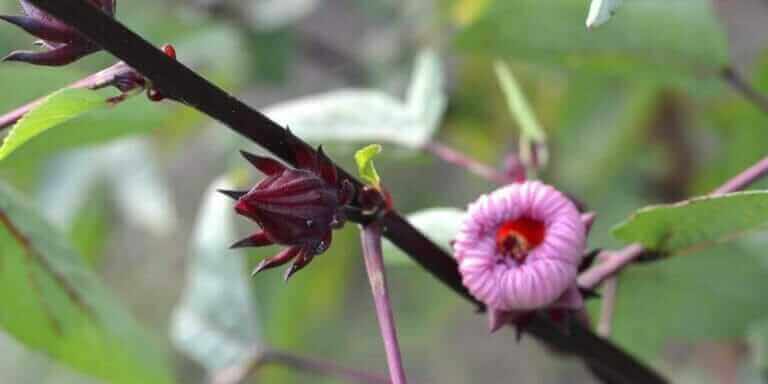
Hi there, I’ve been looking for a recipe for rosella jam that isn’t loaded up with sugar. This looks great! I’m thinking of also adding a bit of apple and lemon for flavor/pectin. My question is, about how long will this stay good in the fridge? Is the shelf life significantly compromised when the large amount of sugar is left out?
Hi Katy, thanks! That’s very interesting about the flavor/pectin addition. Roselle plants are in growth mode right now, and I give it a month before we can make this again, so how long it stays good for I will have to find out. In the past, whether it’s the jam or the juice, I tend to be the house vacuum and nothing stays that long in the fridge (worth eating or drinking), so I don’t know how long it would stay good. Next time we make it I will try and see, so I’ll update this in a while with that info. I’d imagine if you have a screw top container it could stay good a while but I’m not sure! My wife would know more, I’ll ask her today and can update this comment.
Hi there, I tried this recipe and it turned out delicious! Thanks for posting a straightforward, simple recipe that yields beautifully thick jam — my first. I made it with 1.5 lb so added 1.5 tsp of salt which made it too salty for my taste. Do you have any suggestions on how to fix it besides adding more sugar?
Hey Allyria, great to hear! Thanks for the compliment and for trying it out after reading our recipe post. As far as too salty, hm the only thing I can think of is maybe to cancel out the saltiness with another addition. For example, we sometimes boil it with a padan leaf inside which removes any and all bitterness and might balance the salt. At 1.5tsp, I imagine it’s not like wayy too salty in where it’s not consumable, so maybe adding soemthing else in could help it? Since it’s jam you can’t just add a bit more water.. I love salt so I’d probably like your jam! Thanks again for coming by the blog. If I learn of anything else to help the saltiness I’ll comment again.
Hi, thank you so much for the recipe. Today was my first harvest of the King Roselle (large size). It was already on the stove with the cover on the pot when I read your warning about this! 😂😂😂 I hurried to the stove, but it had spilled already over the entire stove. I will use some of the juice and let the rest boil thick to make jam. 👌
Hi Sheila, I just shared this with Ling and she said yup! haha we’re about to make a new batch now this time on a flame stove vs the heat pad one we used last year. I’ll update if anything’s different on this one. We hope your jam and juice turned out excellent!! Thanks for your comment and for coming to our recipe!
If you save and boil the seed pods covered in about 1 inch of water for 30 minutes, that is all the pectin you will need to thicken. Use that liquid to boil the calyxs in instead of just plain water.
Very interesting! In the past I’ve read about reasons you’d want to leave the pectin out, but this could be a good variation if you did want to include the pectin. Thanks for letting me know, we’ll experiment and update when we do.
I made this after boiling the petals to make tea. I then drained off the first liquid for tea, added more water to the pulp as well as some pineapple juice and 4 dates for a 2nd boil. I boiled it down per the recipe and put it in a blender after cooling. Very tasty and very sweet without any added sugar.
A nurseryman in Darwin, northern Australia, recently discovered a new variety of rosella that has much larger and sweeter fruit so you don’t need to use so much sugar in the recipe. You can see the difference in size in the photographs that he published in this article: https://tropicalhousegarden.com/rosella-wonderful-bush-tucker-plant/
I don’t think this variety is available in Thailand yet but it probably won’t be long before someone imports some cuttings. I think it will make the old variety of rosella redundant in the coming years.
Hey David, cool I will check this out. I’d love to get some of those cuttings or seeds! Our normal Rosella is great, we don’t put any sugar and it’s great. I would really like to try yours though. Maybe one day if the unnecessary lockdowns stop we can fly down under and get them ourselves. Cheers and God bless.
Dear John & Ling,I discovered Rosella by chance when an old schoolmate handed me bags of her garden produce ( all organic – we joked that’s becos fertilizers/pesticides are costly).She included a ziplock bag of dried Roselle calyx.They made wonderful drinks with lovely hue !! We have the newer,darker maroon red variety.
After using numerious exotic flower drinks over the years,I thought there’s no comparison to Rooibos and Elder Flowers,I was wrong.
I write to let you know how much I appreciated your post esp. sequential pictures on Rosella jam making ( I hate the speed of You-Tube video while making things using its video as a cooking guide). I’m about to make some Rosella jam ( having been making Seville Mamalade all my life)- Xmas gift won’t be the same this year.
Isn’t that crazy how the worse stuff is more expensive? It’s getting harder to find organic seeds, everything is GMO now, so that’s an excellent gift and a good friend you have! I will have to look for Rooibos and Elder Flower now to try this tea. Thanks for letting me know about these. Thanks for the compliment on the recipe post:) Hope your jam turns and turned out wonderful!!!